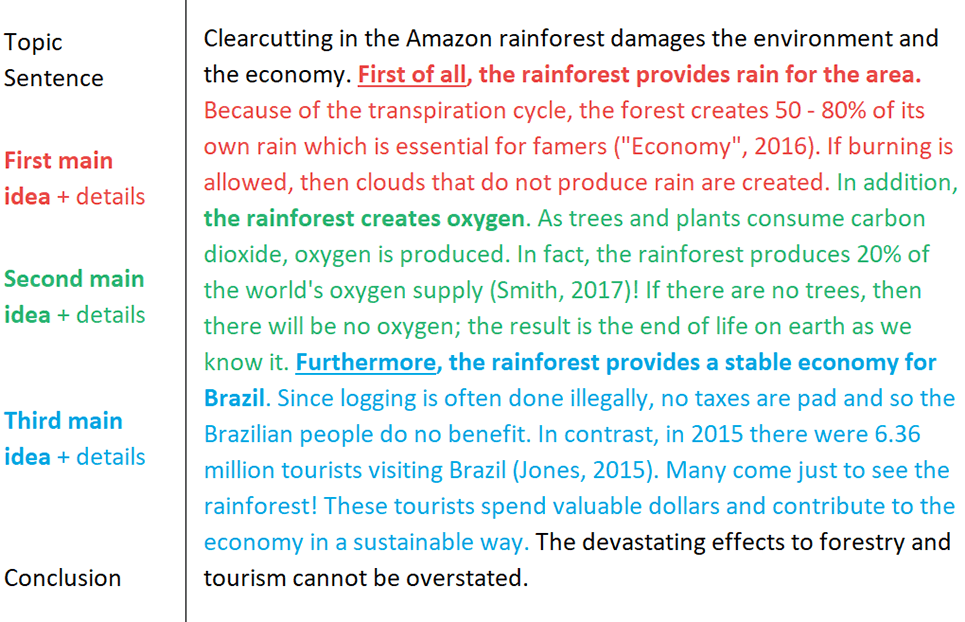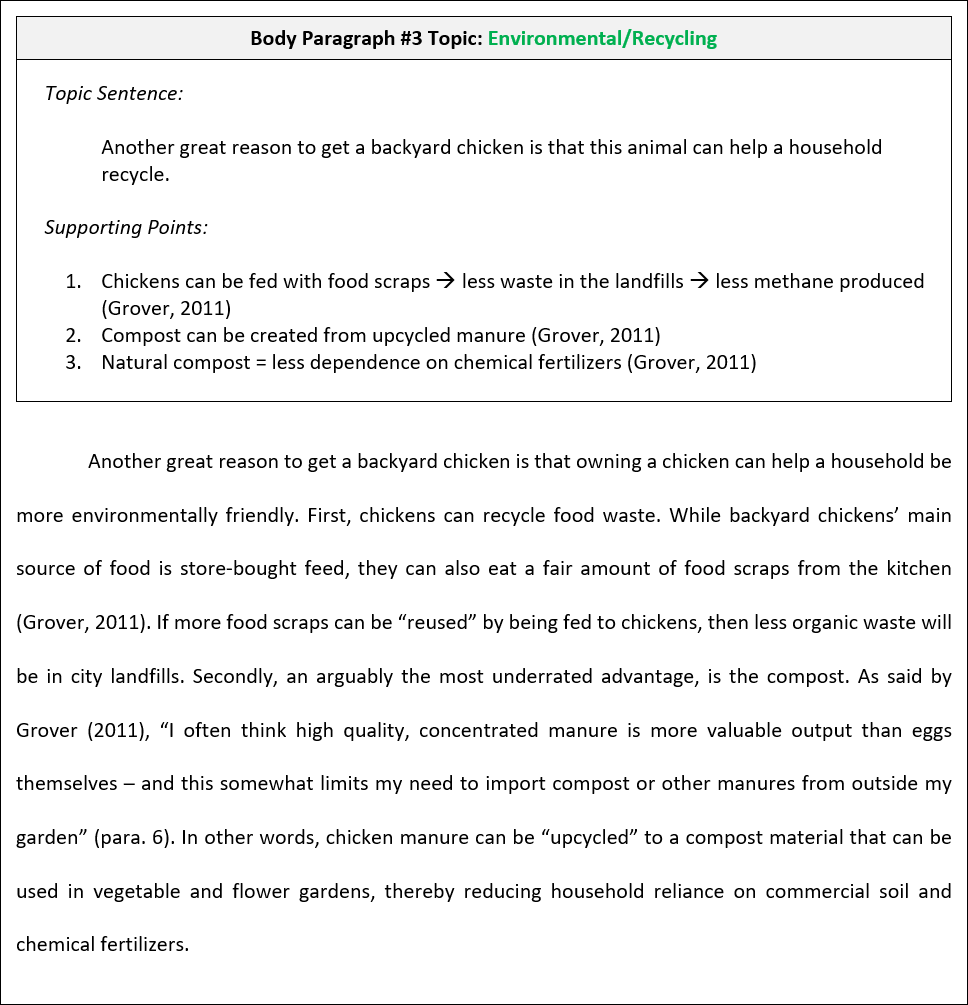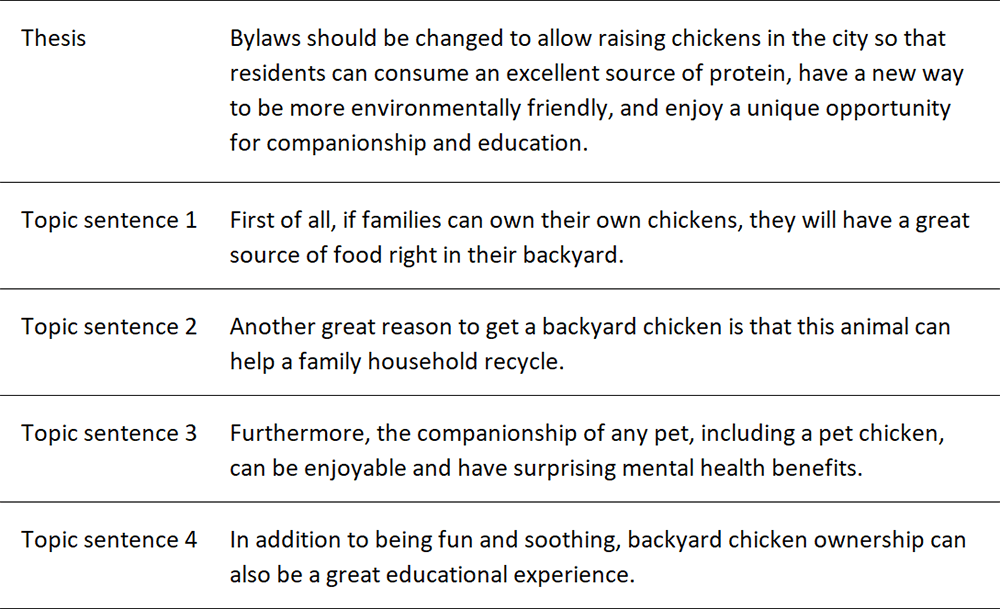11 Writing Topic Sentences and Body Paragraphs
In academic writing, Canadian professors expect you to adhere to a very specific and formal organization. This organizational style reflects the direct, linear, and explicit style of communication preferred by low-context cultures.
Learning Objectives[1]
After completing this chapter, you will be able to
- identify characteristics of a body paragraph (University of Minnesota Libraries Publishing, 2015)
- evaluate the effectiveness of topic sentences (University of Minnesota Libraries Publishing, 2015)
- evaluate the effectiveness of support within body paragraphs
- recognize concluding statements
Basic Paragraph Structure
Composing an effective paragraph is like building a house. You may have the finest content or materials, but if you do not arrange them in the correct order, then the final product will not hold together very well.
Imagine that your paragraph is a big, juicy hamburger:
- Top bun: The topic sentence introduces the main idea of the paragraph.
- Meat: The body is composed of the supporting sentences that develop the main point.
- Bottom bun: The conclusion is the final sentence that restates the main point.
Developing a Topic Sentence
The topic sentence relates to the thesis, or main point, of the essay and guides the reader by signposting what the paragraph is about. All of the sentences in the rest of the paragraph must support the topic sentence.
An effective topic sentence combines a main idea with the writer’s personal attitude or opinion. It serves to orient the reader and provides an indication of what will follow in the rest of the paragraph. Read the following example.
Creating a national set of standards for math and English education will improve student learning in many provinces.
This topic sentence declares a favorable position for standardizing math and English education. After reading this sentence, a reader will expect the writer to provide supporting details and facts as to why standardizing math and English education might improve student learning in many provinces. If the purpose of the essay is actually to evaluate education in only one particular province, or to discuss math or English education specifically, then the topic sentence is misleading and inappropriate.
Tip
When writing a draft of an essay, allow a friend or colleague to read the opening line of your first paragraph. Ask your reader to predict what your paragraph will be about. If they are unable to guess your topic accurately, you should consider revising your topic sentence so that it clearly defines your purpose in writing.
Main Idea versus Controlling Idea
Topic sentences contain both a main idea (the subject, or topic, that the writer is discussing) and a controlling idea (the writer’s specific stance, or point of view, on that subject). Different writers may use the same main idea but can steer their paragraph in a number of different directions according to their stance on the subject. Read the following examples.
(a) Marijuana causes long-term brain damage in adolescent users.
(b) The anti-nausea properties in marijuana are a lifeline for many cancer patients.
(c) Legalizing marijuana would create a higher demand for Class A and Class B drugs.
Although the main idea—marijuana—is the same in all three topic sentences, the controlling idea differs depending on the writer’s viewpoint.
Remember that the body paragraphs of an essay need to support the thesis given in the introduction. If you were writing an essay about the benefits of marijuana legalization, you might include a paragraph with topic sentence (b) because the controlling idea, or stance, in that topic sentence indicates a positive opinion of marijuana. If you were writing a paragraph arguing against legalization, you might include paragraphs starting with topic sentences (a) and (c) because the controlling idea in both is that marijuana is dangerous.
Learning Check
Topic Sentences for Body Paragraphs
When you are creating body paragraphs as part of a larger essay, remember that your body paragraphs need to support your thesis. Each paragraph should be helping to explain your point of view on the topic.
Topic Sentence Checklist
- Do they support your thesis?
- Do they clearly state the topic of the paragraph?
- Are they in your own words (not a quote or paraphrase)?
- Do they start with a transitional element?
Consider this research paper skeleton. Notice how each topic sentence relates to the thesis statement by supporting the author’s point of view that bylaws should be changed to enable city residents to keep chickens in their backyards.
Exercise 1
Using the tips on developing effective topic sentences in this section, create a topic sentence on each of the following subjects. Remember to include a controlling idea as well as a main idea.
- An endangered species
- The cost of fuel
- The legal drinking age
- A controversial film or novel
Support in Body Paragraphs
Your topic sentence introduces the “topic” of the paragraph, so it is a fairly vague statement. The topic sentence should not include any statistics or specific details – these belong in the body of the paragraph.
Consider this body paragraph from an essay opposing the clear cutting of the rainforest:

Notice that the support is specific and verifiable: facts, statistics, and logical chains of reasoning are used to persuade the reader that clear cutting is a bad idea. Also, notice that citations are used to indicate the source of the information. Providing cited information is a lot more persuasive than providing your personal opinions.
Weak Support: Many foods today are processed and made with lots of sugar and salt (Smith, n.d.).
Stronger Support: One serving of processed foods, such as a half a can of tomato juice, can contain as much as four times a person’s daily salt intake (Smith, n.d.).
Here’s another example[2]. You can see how the writer has used her outline to help her develop this supporting paragraph:

Concluding Statements
Look back at the example paragraph on rainforest clear-cutting. Look again at the topic sentence and the final sentence of the paragraph. Notice how the final sentence echos the topic sentence.
- Anonymous. (2015, October 27). 6.2 Effective means for writing a paragraph. In Writing for Success. University of Minnesota Libraries. https://bit.ly/3vhpDkr. CC BY-NC-SA 4.0. ↵
- Veillieux, H. (2022, April 14). BodyParagraph_Development [Digital Image]. In Writing topic sentences and body paragraphs. Confederation College. CC BY 4.0. ↵

